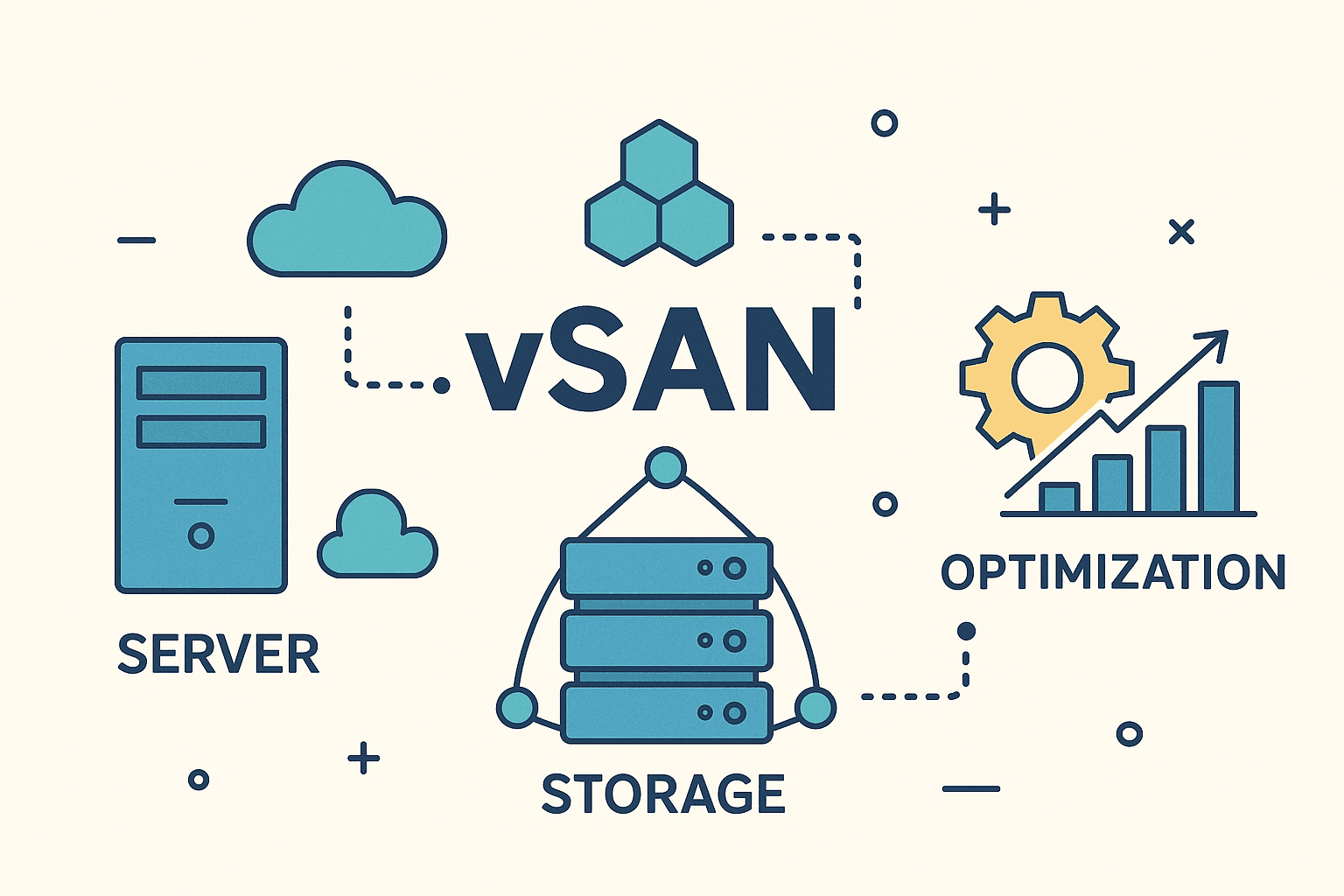What is vSAN?
Terms related to simplyblock
vSAN (Virtual Storage Area Network) is a software-defined storage solution developed by VMware. It integrates tightly with VMware vSphere and allows organizations to pool local storage devices (such as hard drives or SSDs) across a cluster of servers into a single storage resource. This resource is then accessible as if it were a traditional SAN (Storage Area Network), but with the flexibility and cost-effectiveness offered by software-defined technologies. vSAN is ideal for organizations seeking highly scalable and performance-driven storage solutions.
How vSAN Works
vSAN aggregates local storage from servers in a vSphere cluster and turns it into a distributed storage resource. It uses VMware’s Distributed Resource Scheduler (DRS) and Storage Policy-Based Management (SPBM) to optimize storage placement and ensure optimal performance across the environment. Storage is allocated according to policies, including redundancy and performance requirements.
🚀 Optimize Storage with Simplyblock for vSAN-like Performance
Use Simplyblock to achieve scalable, high-performance storage solutions with minimal complexity.
👉 Use Simplyblock for Scalable Storage Solutions →
Key Features of vSAN
vSAN provides several key features that help organizations optimize their storage environments. These features enable businesses to enhance scalability, performance, and efficiency while reducing the complexity of managing traditional storage solutions.
- Software-Defined Storage: vSAN abstracts and virtualizes physical storage into a pool of resources, eliminating the need for traditional, expensive storage hardware.
- Integration with VMware vSphere: It is designed to work seamlessly with VMware’s vSphere, making it particularly attractive for businesses already using VMware’s virtualization platform.
- Scalability: vSAN can scale storage capacity as business needs grow. Additional storage can be added by simply adding more storage devices or servers to the cluster.
- High Availability and Resiliency: Built-in redundancy and fault tolerance ensure that if a storage device or server fails, data remains accessible, preventing downtime and data loss.
- Performance Optimization: vSAN provides high performance for workloads that require low latency and high throughput, thanks to its use of all-flash or hybrid configurations.
- Cost Efficiency: By leveraging local storage and eliminating the need for expensive storage arrays, vSAN offers a more cost-effective alternative to traditional SAN solutions.

Comparing vSAN, Simplyblock, and Legacy SAN
vSAN provides a more flexible and cost-effective solution compared to traditional SAN. It eliminates the need for dedicated hardware and simplifies storage management, offering scalability and performance benefits.
| Feature | vSAN | Simplyblock | Legacy SAN |
|---|---|---|---|
| Architecture | Software-defined storage | Software-defined storage | Hardware-based, dedicated arrays |
| Scalability | Easily scalable by adding servers | Seamlessly scalable with NVMe over TCP | Scaling requires additional SAN hardware |
| Cost | Cost-effective, utilizes local storage | Cost-effective, no additional hardware needed | Expensive, requires dedicated storage hardware |
| Management | Managed via VMware vCenter | Managed via centralized interface, integrates with Kubernetes and VMware | Managed separately, often requiring specialized tools |
| Performance | High-performance with SSDs or hybrid configurations | Near-local performance with latencies under 1ms | High-performance but dependent on dedicated hardware |
vSAN Benefits
- Simplified Management: By integrating with VMware vSphere, vSAN simplifies storage management within VMware environments. IT teams can manage both compute and storage through a single platform. For more details, check the official VMware vSAN Documentation.
- Improved Performance: vSAN provides fast, high-performance storage capabilities, particularly when configured with all-flash setups.
- Reduced Complexity: It eliminates the need for managing separate storage arrays, reducing both complexity and operational overhead in enterprise IT environments.
- Scalable Storage: As business requirements grow, vSAN provides simple, scalable storage without the need for major hardware investments.
Use Cases for vSAN
- Virtualized Environments: Ideal for organizations using VMware for server virtualization. It integrates well with VMware vSphere, vCenter, and VMware Cloud Foundation.
- Remote Offices/Branch Offices (ROBO): vSAN is a cost-effective solution for remote sites needing centralized storage with minimal overhead.
- Hybrid and Multi-Cloud: vSAN can integrate with cloud environments, offering a bridge between on-premises data centers and public cloud storage solutions.
Why Choose Simplyblock Over vSAN
Simplyblock offers a more scalable, cost-effective alternative to vSAN. It uses NVMe over TCP for near-local storage performance with latencies under 1 millisecond. Simplyblock integrates easily with Kubernetes, VMware, and other environments, simplifying scaling and management.
With features like thin provisioning, erasure coding, and automated tiering, Simplyblock delivers greater efficiency and flexibility for high-performance workloads, making it an ideal choice for modern enterprises.
vSAN Scalability and Performance
vSAN scales easily by adding servers, making it suitable for dynamic environments with growing performance and capacity needs. Its all-flash configurations are ideal for high-performance workloads.
However, Simplyblock offers superior cost efficiency and flexibility with NVMe over TCP, providing near-local storage performance with latencies under 1 millisecond, without the need for additional hardware. Simplyblock is the ideal solution for enterprises seeking high-performance, scalable, and cost-effective storage.
Questions and answers
vSAN works well in legacy virtualized setups but is less ideal for cloud-native architectures. Kubernetes and containerized workloads often demand more dynamic and scalable storage solutions like NVMe over TCP, which provide better performance and CSI integration.
While vSAN pools local disks across nodes, NVMe over TCP enables high-speed access to remote NVMe storage over Ethernet. NVMe/TCP outperforms vSAN in latency, throughput, and scalability, especially for Kubernetes storage and data-intensive workloads.
vSAN has limited CSI integration and flexibility, making it less suitable for dynamic, stateful Kubernetes applications. Simplyblock’s CSI driver enables native support for encrypted, high-performance NVMe volumes on Kubernetes.
vSAN is a solid option for VMware environments but doesn’t fully replace SANs in hybrid or containerized infrastructures. Software-defined storage solutions offer greater agility and better alignment with modern DevOps and cloud strategies.
Yes, vSAN includes basic data-at-rest encryption, but advanced use cases like multi-tenant isolation or Kubernetes-native security may require more flexible options. Simplyblock DARE supports per-volume encryption and integrates with external KMS for enhanced security.
